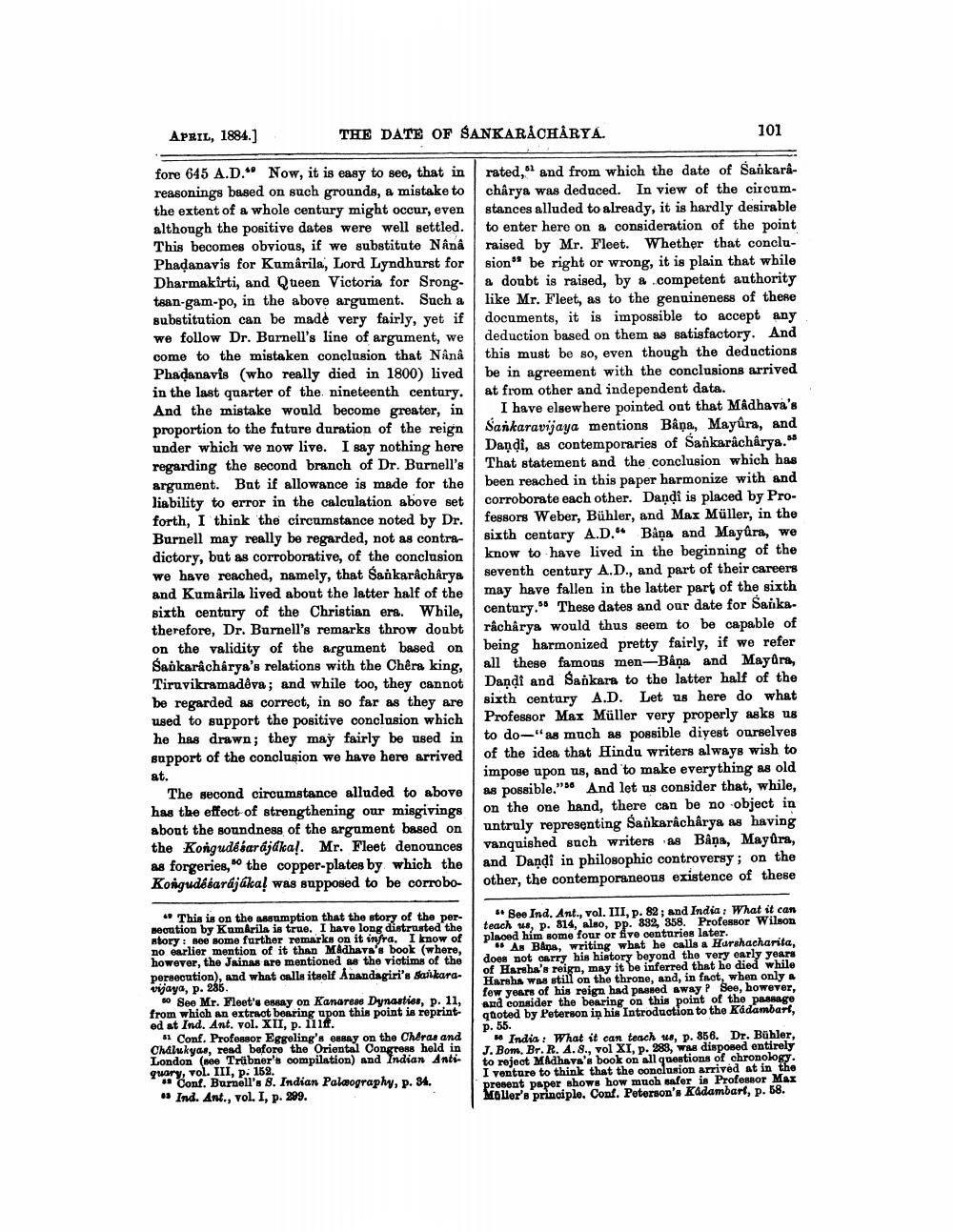________________
APRIL, 1884.)
THE DATE OF SANKARÁCHÅRYA.
101
fore 645 A.D." Now, it is easy to see, that in rated," and from which the date of Sankarareasonings based on such grounds, a mistake to charya was deduced. In view of the circumthe extent of a whole century might occur, even stances alluded to already, it is hardly desirable although the positive dates were well settled. to enter here on a consideration of the point This becomes obvious, if we substitute Nânâ raised by Mr. Fleet. Whether that concluPhadanavis for Kumârila, Lord Lyndhurst for sion" be right or wrong, it is plain that while Dharmakirti, and Queen Victoria for Srong. a doubt is raised, by & .competent authority tsan-gam-po, in the above argument. Such a like Mr. Fleet, as to the genuineness of these substitution can be made very fairly, yet if documents, it is impossible to accept any we follow Dr. Barnell's line of argument, we deduction based on them as satisfactory. And come to the mistaken conclusion that Nâná this must be so, even though the deductions Phadanavis (who really died in 1800) livedbe in agreement with the conclusions arrived in the last quarter of the nineteenth century. at from other and independent data. And the mistake would become greater, in I have elsewhere pointed out that Madhava's proportion to the future duration of the reign Sankaravijaya mentions Bâņa, Mayura, and under which we now live. I say nothing here Dandi, as contemporaries of Sankaracharya." regarding the second branch of Dr. Burnell's That statement and the conclusion which has argument. But if allowance is made for the been reached in this paper harmonize with and liability to error in the calculation above set corroborate each other. Dandi is placed by Proforth, I think the circumstance noted by Dr. fessors Weber, Bühler, and Max Müller, in the Burnell may really be regarded, not as contra- sixth centary A.D." Båņa and Mayûra, we dictory, but as corroborative, of the conclusion know to have lived in the beginning of the we have reached, namely, that Sankaracharya seventh century A.D., and part of their careers and Kumärila lived about the latter half of the may have fallen in the latter part of the sixth sixth century of the Christian ere. While, century. These dates and our date for Sankatherefore, Dr. Burnell's remarks throw doubt racharya would thus seem to be capable of on the validity of the argument based on being harmonized pretty fairly, if we refer Sankaracharya's relations with the Chêra king, all these famous men-Bâņa and Mayors, Tiruvikramadêva; and while too, they cannot Dandi and Sankara to the latter half of the be regarded as correct, in so far as they are sixth century A.D. Let us here do what used to support the positive conclusion which
Professor Max Müller very properly asks us he has drawn; they may fairly be used in to do- as much as possible diyest ourselves support of the conclusion we have here arrived
of the idea that Hindu writers always wish to at.
impose upon us, and to make everything as old The second circumstance alluded to above as possible." And let us consider that, while, has the effect of strengthening our misgivings on the one hand, there can be no object in abont the soundness of the argument based on untruly representing Sankaracharya as having the Kongudésar ájdka!. Mr. Fleet denounces vanquished such writers as Bảna, Mayora, as forgeries, the copper-plates by which the and Dandi in philosophic controversy ; on the Kongudesarájáka! was supposed to be corrobo- other, the contemporaneous existence of these
- This is on the assumption that the story of the perneontion by Kumarila is true. I have long distrusted the story: see some further remarks on it infra. I know of no earlier mention of it than Madhava's book (where, however, the Jainas are mentioned as the victims of the persecution), and what calls itself Anandagiri's Sankara. vijaya, p. 285.
60 See Mr. Fleet's essay on Kanarese Dynasties, p. 11, from which an extract bearing upon this point is reprinted at Ind. Ant. vol. XII, p. 111ff.
- Conf. Professor Eggeling's hay on the Cheras and Chalukyas, read before the Oriental Congress held in London (see Trübner's compilation) and Indian Antiquary, vol. III, p. 152.
Conf. Burnell's 8. Indian Palæography, p. 84. " Ind. Ant., vol. I, p. 299.
"Bee Ind. Ant., vol. III, p. 82 ; and India : What it can teach w, p. 814, also, pp. 892, 358. Professor Wilson placed him some four or five centuries later.
"As Bana, writing what he calls a Harshacharita, does not carry his history beyond the very early years of Harsha's reign, may it be inferred that he died while Harshe was still on the throne, and, in fact, when only few years of his reign had prased away P See, however, and consider the bearing on this point of the passage quoted by Peterson in his Introduction to the Kadambart, p. 55.
0 India: What it can teach 18, p. 856. Dr. Bühler, J. Bom, Br. R. 4.8., vol XI, p. 283, was disposed entirely to reject Madhava's book on all questions of chronology. I venture to think that the conclusion arrived at in the prenent paper shows how much safer in Professor Max Moller's principle. Conf. Peterson's Kadambart, p. 58.




